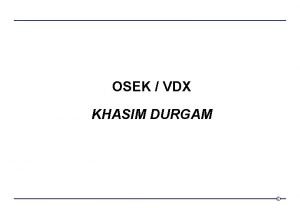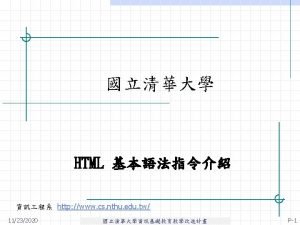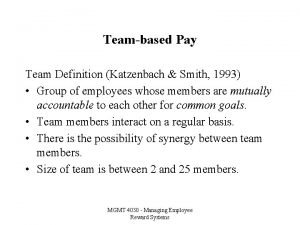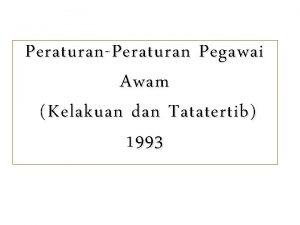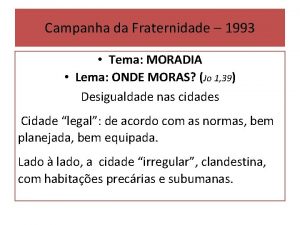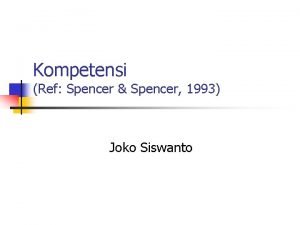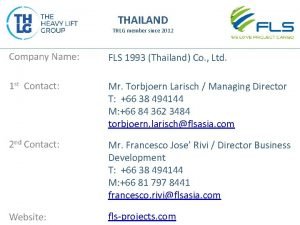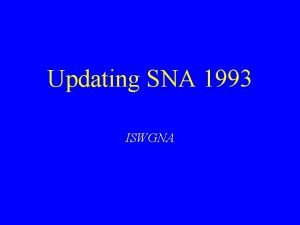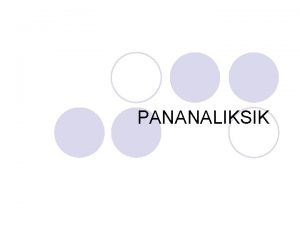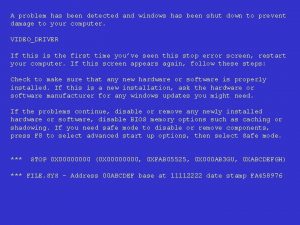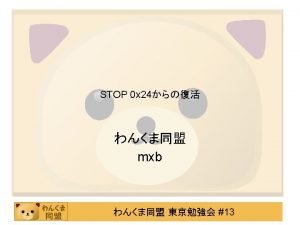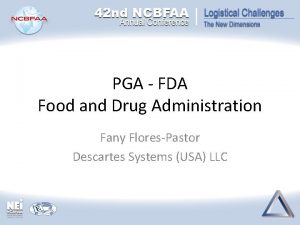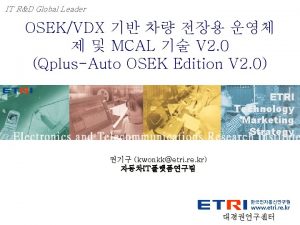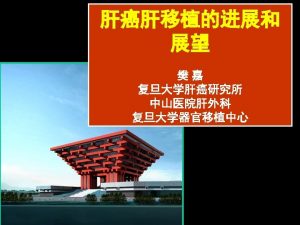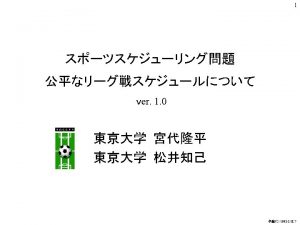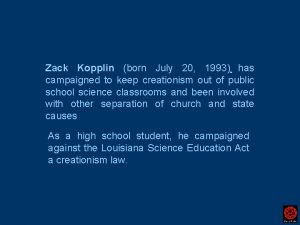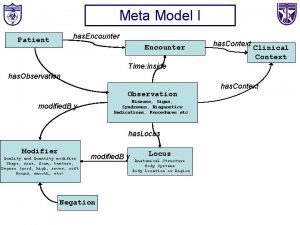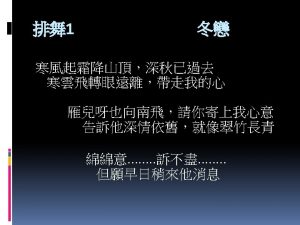1 1 OSEKVDX In May 1993 OSEK has
























































- Slides: 56



1. 1 什么是OSEK/VDX? In May 1993 OSEK has been founded as a joint project in the German automotive industry aiming at an industry standard for an open-ended architecture for distributed control units in vehicles. OSEK is an abbreviation for the German term "Offene Systeme und deren Schnittstellen für die Elektronik im Kraftfahrzeug" (English: Open Systems and the Corresponding Interfaces for Automotive Electronics). Initial project partners were BMW, Bosch, Daimler. Chrysler, Opel, Siemens, VW and the IIIT of the University of Karlsruhe as co-ordinator. The French car manufacturers PSA and Renault joined OSEK in 1994 introducing their VDX-approach (Vehicle Distributed e. Xecutive) which is a similar project within the French automotive industry. At the first workshop on October 1995 the OSEK/VDX group presented the results of the harmonised specification between OSEK and VDX. 电子科技大学嵌入式软件 程中心 After the 2 nd international OSEK/VDX Workshop in October 1997

• The open architecture introduced by OSEK/VDX comprises the three areas: – Communication (data exchange within and between control units) – Operating System (real-time execution of ECU software and base for the other OSEK/VDX modules) – Network Management (Configuration determination and monitoring) 电子科技大学嵌入式软件 程中心

• Motivation – high, recurring expenses in the development and variant management of non-application related aspects of control unit software – incompatibility of control units made by different manufactures due to different interfaces and protocols • Goal – Support of the portability and reusability of the application software by: • specification of interfaces which are abstract and as applicationindependent as possible • specification of an user interface independent of hardware and network • efficient design of architecture: The functionalities shall be configurable and scalable, to enable optimal adjustment of the architecture to the application in question • verification of functionality and implementation of prototypes in selected pilot projects 电子科技大学嵌入式软件 程中心

• Structure – The Steering Committee is responsible for the overall project organization and co-ordination (e. g. assignment of working group leaders), for granting of licenses to other companies, and for the external representation of OSEK/VDX (e. g. publications). – The participation in the Technical Committee offers associated partners to actively co-operate in OSEK/VDX. • Currently the technical committee is formed by the initial OSEK/VDX partners and over 50 associated partners from different industries related to automotive electronics, i. e. car manufacturers, automotive suppliers, semiconductor industries and software companies. • Obviously, OSEK/VDX is open for the integration of additional associated partners. 电子科技大学嵌入式软件 程中心


1. 2 System philosophy • Automotive applications are characterized by stringent real-time requirements. – Therefore the OSEK operating system offers the necessary functionality to support event driven control systems. • The specified operating system services constitute a basis to enable the integration of software modules made by various manufacturers. • As the operating system is intended for use in any type of control units, it shall support time-critical applications on a wide range of hardware. • For time-critical applications dynamic generation of system objects was left out. – Instead, generation of system objects was assigned to the system generation phase. 电子科技大学嵌入式软件 程中心

• Standardized interfaces – The interface between the application software and the operating system is defined by system services. – The interface is identical for all implementations of the operating system on various processor families. • Scalability – feasible for a broad spectrum of applications and hardware: • Different conformance classes, various scheduling mechanisms and the configuration features make the OSEK operating system. – require only a minimum of hardware resources (RAM, ROM, CPU time) and therefore runs even on 8 bit microcontrollers. • Error checking – offers two levels of error checking: • extended status for development phase • standard status for production phase 电子科技大学嵌入式软件 程中心

• Portability of application software – means the ability to transfer an application software module from one ECU to another ECU without bigger changes inside the application. – For better portability of application software, the OSEK defines a language for a standardized configuration information. • Support of Portability – The certification process ensures the conformance of different implementations to the specification. 电子科技大学嵌入式软件 程中心

• Service groups – Task management • Activation and termination of tasks • Management of task states, task switching – Synchronization – The operating system supports two means of synchronization effective on tasks: • Resource management Access control for inseparable operations to jointly used (logic) resources or devices, or for control of a program flow. • Event control Event management for task synchronization. – Interrupt management • Services for interrupt processing – Alarms • Relative and absolute alarms – Intra processor message handling • Services for exchange of data – Error treatment • Mechanisms supporting the user电子科技大学嵌入式软件 程中心 in case of various errors





2. 1 Processing levels • The OSEK operating system provides a defined set of interfaces for the user. These interfaces are used by entities which are competing for the CPU. There are two types of entities: – Interrupt service routines managed by the operating system – Tasks (basic tasks and extended tasks) 电子科技大学嵌入式软件 程中心

• OSEK defines three processing levels Interrupt level Logical level for scheduler Task level 电子科技大学嵌入式软件 程中心

2. 2 Conformance classes (符合类级别) • Various requirements of the application software for the system and various capabilities of a specific system (e. g. processor, memory) demand different features of the operating system. • Conformance classes exist to support the following objectives: – To provide convenient groups of operating system features for easier understanding and discussion of the OSEK operating system. – To allow partial implementations along pre-defined lines. These partial implementations may be certified as OSEK compliant. – To create an upgrade path from classes of lesser functionality to classes of higher functionality with no changes to the application using OSEK related features. 电子科技大学嵌入式软件 程中心

















2. 5 任务管理 • Two different task concepts are provided by the OSEK operating system: • Basic Tasks – only release the processor, if • they terminate, • the OSEK operating system switches to a higher-priority task, or • an interrupt occurs which causes the processor to switch to an interrupt service routine (ISR). • Extended Tasks – allow to use the operating system call Wait. Event, which may result in a waiting state. – In view of the operating system, management of extended tasks is, in principal, more complex than management of basic tasks and requires more system resources. 电子科技大学嵌入式软件 程中心



2. 5. 2 任务优先级 • The value 0 is defined as the lowest priority of a task. Accordingly bigger numbers define higher priorities. • To enhance efficiency, a dynamic priority management is not supported. – Accordingly priority of a task is defined statically, i. e. the user cannot change it at the time of execution. However, in particular cases the operating system can treat a task with a defined higher priority (OSEK Priority Ceiling Protocol). • Tasks on the same priority level are started depending on their order of activation. – A preempted task is considered to be the first (oldest) task in the ready list of its current priority. – A task being released from the waiting state is treated like the last (newest) task in the ready queue of its priority. 电子科技大学嵌入式软件 程中心










• 抢占式调度时机举例: – Successful termination of a task (system service Terminate. Task). – Successful termination of a task with explicit activating of a successor task (system service Chain. Task). – Activating a task at task level (e. g. system service Activate. Task, message notification mechanism, alarm expiration). – Explicit wait call if a transition into the waiting state takes place (extended tasks only, system service Wait. Event). – Setting an event to a waiting task at task level (e. g. system service Set. Event, message notification mechanism, alarm expiration, if event setting defined). – Release of resource at task level (system service Release. Resource) – Return from interrupt level to task level 电子科技大学嵌入式软件 程中心

• 非抢占式调度时机 – rescheduling in the following cases: • Successful termination of a task (system service Terminate. Task). • Successful termination of a task with explicit activation of a successor task (system service Chain. Task). • Explicit call of scheduler (system service Schedule). • A transition into the waiting state takes place (system service Wait. Event). – Implementations of non preemptive systems may prescribe that operating system services which cause rescheduling may only be called at the highest task program level (not in task subfunctions). • A task switch at these points of scheduling usually requires saving of less task context information. 电子科技大学嵌入式软件 程中心

– The definition of a non preemptable task makes sense in a full preemptive operating system • if the execution time of the task is in the same magnitude of the time of a task switch, • if RAM is to be used economically to provide space for saving the task context, or • if the task shall not be preempted. • Many applications comprise only few parallel tasks with a long execution time, for which a full preemptive operating system would be convenient – and many short tasks with a defined execution time where non preemptive 电子科技大学嵌入式软件 程中心 scheduling would be more efficient.






 Osek nm vs autosar nm
Osek nm vs autosar nm What is osek
What is osek Freeosek
Freeosek Hci patterns
Hci patterns Anthony 1993 recovery
Anthony 1993 recovery Pengertian komunikasi menurut taylor
Pengertian komunikasi menurut taylor Html
Html Passenger vessel safety act of 1993
Passenger vessel safety act of 1993 Ley 87
Ley 87 Katzenbach and smith 1993
Katzenbach and smith 1993 Towards a language-based theory of learning
Towards a language-based theory of learning Jenis hukuman tatatertib
Jenis hukuman tatatertib 1993 1994 1995 1996 1997 1998 1999 2000 2001 2002
1993 1994 1995 1996 1997 1998 1999 2000 2001 2002 Korthagen 1993
Korthagen 1993 Peraturan 3c, p.u(a) 395/1993
Peraturan 3c, p.u(a) 395/1993 Antikythera mechanism age
Antikythera mechanism age Aashto 1993 flexible pavement design example
Aashto 1993 flexible pavement design example Bruyat 1993
Bruyat 1993 October 3rd 1993
October 3rd 1993 Intel pentium processor architecture
Intel pentium processor architecture The new face of america time magazine
The new face of america time magazine Spencer and spencer 1993
Spencer and spencer 1993 European union history
European union history Peraturan 3a, p.u(a) 395/1993
Peraturan 3a, p.u(a) 395/1993 Mapa curricular 1993
Mapa curricular 1993 Akta pusat jagaan 1993
Akta pusat jagaan 1993 Yashpal committee 1993
Yashpal committee 1993 Campanha da fraternidade 1993
Campanha da fraternidade 1993 Otkup starih novcanica iz 1993
Otkup starih novcanica iz 1993 Texas descent and distribution before 1993
Texas descent and distribution before 1993 Spencer 1993
Spencer 1993 Fls 1993
Fls 1993 Sna 1993
Sna 1993 Ibigay ang kahulugan ng pananaliksik
Ibigay ang kahulugan ng pananaliksik Intel 1993
Intel 1993 Aashto structural number calculator
Aashto structural number calculator Windows nt 1993
Windows nt 1993 Sentences that start with unless
Sentences that start with unless The weather has been nice but it may snow again any day
The weather has been nice but it may snow again any day When someone has been drinking they may drive poorly
When someone has been drinking they may drive poorly Ever since the big blowout she and i haven't gotten along
Ever since the big blowout she and i haven't gotten along Windows a problem has been detected
Windows a problem has been detected Every picture has a story and every story has a moment
Every picture has a story and every story has a moment Windows has been shutdown to prevent damage
Windows has been shutdown to prevent damage Whoever has ears let them hear
Whoever has ears let them hear Spring has sprung the grass has riz
Spring has sprung the grass has riz What is density
What is density An object may have
An object may have Th m
Th m Britanska rokovska skupina
Britanska rokovska skupina 12th may 2008
12th may 2008 May affect our
May affect our Frankenstein setting time and place
Frankenstein setting time and place Flower of may site fees
Flower of may site fees Kate di camilo
Kate di camilo Aphis aq1
Aphis aq1 Site:slidetodoc.com
Site:slidetodoc.com

